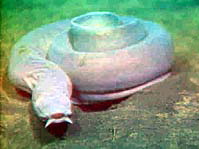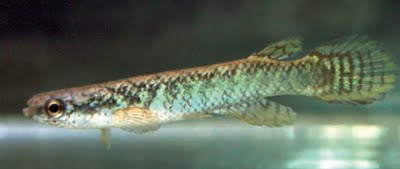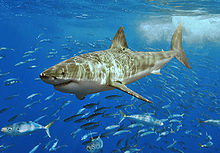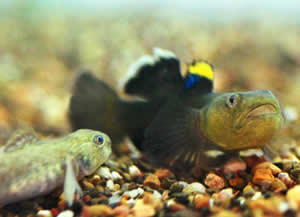Will grey seals counteract cod recovery in the Baltic Sea?
Grey seals and cod used to be found in great abundance throughout the Baltic Sea, but today the seals are chiefly present in the northern parts of the sea while the cod is found in the south.
Hilton stops serving sailfish and marlin in Costa Rica
Four Hilton Worldwide hotels in Costa Rica have pledged to stop serving sailfish and marlin after entering into an agreement with the Billfish Foundation (TBF) and the Costa Rica Sport Fishing Federation (FECOPT).
China Releases 1.3 Billion Fish into Yangtze River
Last week, 1.3 billion fish were released into the Yangtze River by the Chinese Ministry of Agriculture (MOA). The release took place in the provinces of Jiangxi, Hubei, Hunan, Anhui and Jiangsu in the middle and lower reaches of the river.
New species of Brazilian killifish described by science
A new species of killifish native to Brazil has been formally described and given a scientific name. The fish, from now on known as Rivulus albae, belongs to the subgenus Melanorivulus and was found in soft and acidic water in northeastern Brazil.
The fish is named after Alba Garcia, the daughter of José Ramón García, one of the authors of the paper in which the species is described.
Appearance
Rivulus albae distinguishes itself from the other members of the subgenus Melanorivulus by having brown oblique bars on the entire flank which on the dorsal portion of the flank often form chevron-like marks with a posterior vertex (vs. chevron-like pattern with vertex pointing anteriorly when present).
Rivulus albae looks quite similar to Rivulus decoratus, but has 6 branchiostegal rays instead of 5, 13 anal fin rays instead of 10 or 11, and 24-26 scales on lateral series instead of 25-28.
Distribution and habitat
All the other recognized species of the subgenus Melanorivulus live in rivers south of the main channel of the Amazon River, but Rivulus albae was collected north of the Amazon River, in the state of Amapá. So far, the species is only known from a handful of localities belonging to Comprido Lake and Tartaruga Grande River.
Rivulus albae was collected in an environment where the savannah meets the forest, close to the banks of large water bodies with clear water at an altitude up to roughly 50 meters above sea level. This fish lives in lakes and lagoons where the underwater vegetation is dense and the water soft and acidic (pH 6.0-6.5).
Authors
- STEFANO VALDESALICI, ITALYvaldesalici.stefano(at)gmail.com
- JOSÉ RAMÓN GARCÍA GIL, SPAIN
- DALTON TAVARES BRESSANE NIELSEN, BRAZIL
The paper was published in Vertebrate Zoology on June 22, 2011.
http://www.vertebrate-zoology.de/vz61-1/06_Vertebrate_Zoology_61-1_Valdesalici.pdf
The mystery of bonefish spawning solved
The Bonefish is an extremely popular fishing that lures 1000s of sport fishermen to try their luck each year but until now it has been unknown how this species reproduce. Andy Danylchuk, a researcher working at University of Massachusetts Amherst and his colleagues have been studying bonefish for the last few years using using ultrasonic transmitters to tag and track the fishes movements. The research have been conducted outside Bahamas. The results can now be found in the online version of the journal Marine Biology.
The research show that bonefish gather by the thousands at pre-spawning aggregation sites for a few days each month during the spawning season (October to May). This usually take place during the full and new moon. The fish than migrate together out into deeper water at dusk where they than spawn at depths of more than 1000 ft (300m).
Andy Danylchuk says that “One possible benefit of bonefish migrating to offshore locations to spawn is that it increases the dispersal of their fertilized eggs, especially with the high tides that happen with the new and full moons.”
He also says that this is “This is the first time movement patterns of bonefish to deep water have been formally described,” and that “This new understanding of bonefish movement and spawning aggregations has significant implications for their conservation,”
The researcher have tagged and followed a total of 60 fish over two years.
Will a third force field be enough to protect the Great Lakes?
The U.S. Army Corps of Engineers have constructed an electric barrier in the Chicago Sanitary and Ship Canal, a waterway linking the Mississippi River with the Great Lakes watershed. The idea is to prevent Asian carps from entering the Great Lakes where it could wreck havoc with the ecosystem.
Seven species of carps native to Asia have been introduced to the United States, and four of them are considered a threat to the Great Lakes: bighead carp, silver carp, black carp and grass carp.
The new electric barrier is located slightly upstream from two similar barriers in the canal, and consists of underwater electrodes that creates a forced field by emitting rapid pulses. The force field is meant to repel fish and is capable of shocking those that refuse to turn around.
“We now have great flexibility and redundancy”, says Col. Vincent Quarles, commander of the Army Corps’ Chicago district. “We want to deter the Asian carp threat. The barrier is a very good tool.”
Since the early 1970s, Bighead carp and Silver carp have migrated northward on the Mississippi and its tributaries. Environmental groups have called for physically severing the man-made Chicago Sanitary and Ship Canal, which was completed in the year 1900 to connect the Great Lakes with the Mississippi drainage basins.
Michigan and four other Great Lakes states also wish to sever the canal, and there is currently a federal lawsuit pending against the Army Corps. The Army Corps have pledged to consider that option in a comprehensive study, but that study is not scheduled for completion until 2015.
The first electrical underwater fence in the Chicago Sanitary and Ship Canal was activated in 2002, while the second one was turned on seven years later. Federal and state officials say that the barriers have performed well, but skeptics keep questioning the effectiveness of the barriers. Scientists with the University of Notre Dame and The Nature Conservancy have reported findings of DNA from both Bighead carp and Silver carp in numerous locations above the barriers. However, no Asian carps have been found, save for one single specimen.
“There are still serious gaps in our knowledge about how well it’s working,” says Thom Cmar, an attorney with the Natural Resources Defense Council. “No one ever imagined these electric barriers would be a permanent solution. They’ve always been just a stopgap idea.”
In a newly released report, the Army Corps acknowledges that the 2 volts per inch used in the barriers may not be enough to deter small fish that are just a few inches in length. Increasing the voltage might however endanger the ships moving flammable items across the canal.
First census finds fewer White Sharks than expected in northeast Pacific Ocean
A team of researchers headed by Taylor Chapple, a UC Davis doctoral student, has made the first rigorous scientific estimate of White shark (Carcharodon carcharias) numbers in the northeast Pacific Ocean.
The researchers used small boats to reach spots in the Pacific Ocean where white whales congregate and lured them into photo range with a fake seal attached to a fishing line. Out of all the photographs taken, 321 photos showed dorsal fin edges. The dorsal fin edges of white sharks are jagged and each individual displays its own unique pattern. The photographs could therefore be used to identify individual sharks – 131 in total.
The research team then entered this information into statistical models to estimate the number of sharks in the region. According to their estimate, there are 219 adult* and sub-adult** white sharks in this area.
“This low number was a real surprise,” says Chapple. “It’s lower than we expected, and also substantially smaller than populations of other large marine predators, such as killer whales and polar bears. However, this estimate only represents a single point in time; further research will tell us if this number represents a healthy, viable population, or one critically in danger of collapse, or something in-between.”
The white shark population in the northeast Pacific Ocean is one of three known white shark populations in the world; the other two are found off the coast of South Africa and off Australia/New Zealand, respectively.
Earlier studies using satellite tagging have shown that the white sharks of the northeast Pacific Ocean have an annual migration pattern. Each year, they move from the region off the coast of central California and Mexico’s Guadalupe Island to the Hawaiian Islands or to an area of open ocean located between the Baja Peninsula and Hawaii. The latter destination has even been dubbed “White Shark Café” due to its popularity among white sharks. After spending some time away from the mainland, the sharks journey back to coastal waters.
“We’ve found that these white sharks return to the same regions of the coast year after year,” says Barbara Block, marine biologist at Stanford University and one of the co-authors of the pioneering white shark census. “It is this fact that makes it possible to estimate their numbers. Our goal is to keep track of our ocean predators.”
The paper “A first estimate of white shark, Carcharodon carcharias, abundance off Central California” (http://dx.doi.org/10.1098/rsbl.2011.0124) has been published in the journal Biology Letters (http://rsbl.royalsocietypublishing.org).
* Adult white sharks are the ones that have reached sexual maturity, something which happens when the male is roughly 13 feet and the female is about 15 feet in length.
**Sub-adults are roughly 8 feet or longer (but has not reached sexual maturity); at this size their dietary focus shifts from mostly fish to mostly marine mammals.
Study co-authors
- Taylor K. Chapple, Wildlife, Fish and Conservation Biology, University of California Davis, USA and Max Planck Institute, Germanyhttp://www.topp.org/user/taylorchapple
- Salvador J. Jorgensen, Hopkins Marine Station of Stanford University, USA and Monterey Bay Aquarium, USAhttp://www.topp.org/blog/salvo
- Scot D. Anderson, Point Reyes National Seashore, USA
- Paul E. Kanive, Department of Ecology, Montana State University, USA
- A. Peter Klimley, Wildlife, Fish and Conservation Biology, University of California Davis, USAhttp://wfcb.ucdavis.edu/people/faculty/klimley.php
- Louis W. Botsford, Wildlife, Fish and Conservation Biology, University of California Davis, USAhttp://wfcb.ucdavis.edu/people/faculty/botsford.php
- Barbara A. Block, Hopkins Marine Station of Stanford University, USAhttp://www-marine.stanford.edu/block.htm
Funding
- The National Oceanic and Atmospheric Association (NOAA) Fisheries through the Partnership for Education in Marine Resource and Ecosystem Management (PEMREM) and the NOAA Fisheries/Sea Grant Fellowship Program
- The Gordon and Betty Moore Foundation
- The National Parks Service’s Pacific Coast Science and Learning Center
- Monterey Bay Aquarium
- UC Davis Bodega Marine Laboratory
- Patricia King, member of the Point Reyes National Seashore Association
Aquarium calamity – are you prepared?
Many pet owners purchase pet insurance for their dogs, cats, horses etcetera but have you ever thought about the insurance needs of your aquarium? While few insurance companies would let you take out a life insurance policy on a guppy or be willing to pay for goldfish surgery, there are other types of insurance that any aquarium owner should consider.
The insurance needs of an aquarium owner can be divided into two categories:
Insurance for the aquarium itself, including equipment and inhabitants
Insurance that covers damages caused by the aquarium, e.g. water damage to the floor and the apartment below you
Your aquariums, their contents, and any damage caused by them may or may not be covered by your homeowner’s or renter’s insurance. You need to check your specific policy to find out more – and don’t forget to read the small print. Many insurance policies have quite a comprehensive exclusion list and it is not unusual for all aquariums, or certain aquariums, to show up on this list. Your insurance company may for instance only be willing to pay for damages caused by an aquarium up to a certain amount of gallons, or only cover aquariums that live up to certain standards. It is also quite common for insurance policies not to cover the inhabitants (livestock) of the aquarium but everything else. Some insurance companies will consider plants and corals inhabitants, while others see them as decor.
If you build your own hobby aquariums this doesn’t necessarily disqualify them from being insured. However, most insurance companies have rules stipulating that only “professional quality” aquariums can be insured. This doesn’t mean that an aquarium has to be built by a professional to insured, only that it has to live up to the same level of quality as a professionally constructed tank. Naturally, this is an area where insurance companies and aquarium owners do not always see eye to eye.
Last but not least, it is common for insurance companies to have a notification limit. If for instance your policy has a $1 500 notification limit, you have to inform the insurance company about any possessions that are worth more than $1 500. If for instance your home is burglarized and you file a claim for a $2 000 necklace that got stolen, the insurance company may refuse to cover the necklace if you failed to notify them about you keeping such a precious piece of jewelery in your home. If you own an aquarium, keep in mind that if you file a claim for the entire aquarium you may hit this $1 500 ceiling even if the tank itself did not cost $1 500 to buy. As any fish owner knows, the dollars can keep piling up quite rapidly. You buy a $500 tank, you add some nice filters and a heater, you get some additional stuff along the way, and soon you’ve reached the notification limit without even realizing it. Take a closer look at your aquarium. Would you file a claim if it was destroyed? If yes, have you notified the insurance company about its value?
Hagfish absorb food directly through its skin

Hagfish
Hagfish, an elongated scavenger found on the bottom of the sea, is truly a weird and wonderful creature. A single fossil of hagfish shows that is has undergone little evolutionary change in the last 300 million years, and the hagfish is believed to the be oldest living connection to the first vertebrate. Its the Hagfish, an elongated scavenger found on the bottom of the sea, is truly a weird and wonderful creature. A single fossil of hagfish shows that is has undergone little evolutionary change in the last 300 million years, and the hagfish is believed to the be oldest living connection to the first vertebrate. Its eyespots can detect light but lacks both lens and extrinsic musculature, and is therefore believed to show a significant step in the evolution of more complex eyes. The hagfish is also famous for exuding vast amounts of a gel-like slime when threatened. An adult hagfish can secrete enough slime to turn a 20 litre (5 gallon) bucket of water into slime in a matter of minutes. When captured, e.g. by a human or predatory fish, it will tie itself in an overhand knot which gradually works its way from the head to the tail of the hagfish, scraping off the slime as it goes, thus freeing the hagfish from its captor and from the slime in one swift movement.
Hagfish eat dead and injured sea creatures and will borrow into the body cavity of a dead (or dying!) animal to devour it from within. Once its full, it can go several months without feeding again.
Now, a new study on hagfish caught near Vancouver Island in Canada has unveiled yet another remarkable fact about the hagfish – it seems as though this fish is actually able to eat with its skin and gills, i.e. absorb nutrients through its skin and gills instead of using its mouth.
A research team* headed by Chris Glover of the University of Canterbury in New Zealand and Bamfield Marine Sciences Center took skin and gill tissue from hagfish and tested the tissues’ absorption of two different amino acids.
“We wanted to start with a simple dissolved organic nutrient, and given the fact that the food source is a large decaying pile of protein, an amino acid seemed to be the best place to start,” says Glover.
When a hagfish has managed to burrow its way into a carcass, it will feed surrounded by a high concentration of dissolved nutrients, so being able to absorb food through more than just its mouth could come in handy.
The results of the study carried out by Glover and his colleges indicate that specific molecular mechanisms exist within the hagfish tissues to move the two tested amino acids into the body of the fish. When researchers increased the concentration of amino acids the tissue increased its absorption – but only up to a certain level.
“A quick and simple calculation suggests that the skin in particular may be capable of absorbing nutrients at levels equivalent to that of the digestive tract!”, says Glover.
There are quite a few invertebrates, including many mollusks and worms, that can absorb nutrients through their skin. But up until now, no vertebrates have been known to have this capacity. The hagfish may represent a transition between the feeding habits of aquatic invertebrates like mollusks and the more specialized digestive systems found in vertebrates. While some organisms exchange nutrients with the water around them in order to maintain their body fluid salt concentrations, the hagfish is – according to Glover – likely to transport amino acid molecules through its skin and gills exclusively to feed itself.
The paper “Adaptations to in situ feeding: novel nutrient acquisition pathways in an ancient vertebrate” has been published in the most recent issue of journal Proceedings of the Royal Society B: Biological Sciences.
* Chris N. Glover (http://www.biol.canterbury.ac.nz/people/glover.shtml) School of Biological Sciences, University of Canterbury, Christchurch, New Zealand Bamfield Marine Sciences Centre, Bamfield, British Columbia, Canada
Carol Bucking (no bio page available) Bamfield Marine Sciences Centre, Bamfield, British Columbia, Canada Department of Zoology, University of British Columbia, British Columbia, Canada
Chris M. Wood (http://www.biology.mcmaster.ca/faculty/wood/wood.htm) Bamfield Marine Sciences Centre, Bamfield, British Columbia, Canada Department of Biology, McMaster University, Ontario, Canada
Are you an “off the beaten path” kind of traveler?
For those who wish to boldly go where just a handful of researchers has gone before, the Algalita Marine Research Foundation is now offering tickets to visit the Great Pacific Garbage Gyre.
In collaboration with Pangaea Explorations, a team of Algalita researchers will embark on a three week long scientific voyage through the Pacific Trash Vortex, a gyre of marine litter located roughly between 135° to 155°W to 42°N.
“We’ll be looking for changes in the accumulation of plastic in the North Pacific Gyre,” says Marcus Eriksen, who will lead the expedition’s research as Algalita’s Director of Project Development. “We suspect there’s greater accumulation, which means more harm to sea life and potentially to humans.”
The cost of each ticket is $10 000, and the net proceeds will be used to fund Algalita’s scientific research and educational outreach.
And even though you’re coughing up $10 000 for your fare, don’t expect a leisure cruise. The Sea Dragon, Pangaea’s 72-foot racing sloop, only have enough room for 14 people, including 4 professional crew members, and guests will be expected to help sail and maintain the vessel, stand watch during the night and cook up some hearty meals in the galley. To be considered for a spot on the Sea Dragon you must be fit enough to pull lines, raise sails and lift 1/3 of your weight. You must also be willing to get some very hands-on experience from garbage sorting.
“On this voyage, you’ll earn your sea legs and rough hands hauling in lines and hoisting sails, but you’ll also be “doing the science” side-by-side with researchers,” says Eriksen. “You’ll need to be fit as you prepare to trawl the sea, sort plastic, preserve samples and catalog it all.”
The ship leaves Hawaii on July 7 2011 and is expected to land in Vancouver on July 27.
To find out more and purchase your ticket, go to http://www.algalita.org/research/NorthPacificGyreVoyage.html



